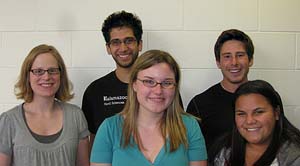
Several Hornets have settled in Wolverine territory this summer, taking advantage of the resources at a large research university by interning in offices and laboratories throughout Ann Arbor. The Kalamazoo College’s Center for Career and Professional Development caught up with four of them:
Psychology major Megan Martinez ’13 is working to understand links between social, psychological, and physical causes of pain. With the guidance of her supervisor, Ross Halpern, M.D., head of Ross Halpern and Associates Psychiatric Clinic, she is reviewing and analyzing patient files for data connecting childhood abuse, grief, and chronic pain. Martinez said she began her internship thinking that “pain was purely a physical phenomenon, one that should be addressed by doctors and medicine. [However] working in Dr. Halpern’s office has helped me realize that pain, particularly chronic pain, is often influenced by social and psychological factors.” Dr. Halpern has given Martinez plenty of opportunity to take responsibility and guide decision-making on their data project, empowering her to recognize her capacity to conduct independent research and analysis.
Kaitlyn Greiner ’15 is working with Upjohn Professor of Medicine and Oncology Stephen Weiss, M.D., at the University of Michigan Life Sciences Institute to identify mechanisms for invasion and growth of brain tumor cells. One of only a few undergraduates accepted into the Weiss research lab, Greiner said she is “learning valuable techniques and tests that I have no doubt I will need to use in my upper-level biology classes,” and is gaining “a great deal of access to both literature regarding my research and people who are very knowledgeable about what they are researching.” Greiner reports that her time in the Weiss lab has allowed her to practice what she learned in her first-year biology classes and “clarified my desire to do medical research.” Greiner has impressed Dr. Weiss with her curiosity and interest, and has already been invited back to the lab next summer.
Chemistry major Sara Adelman ’14 enjoys talking about K with her alumna supervisor, Nichole Hein ’01, M.D., who is “paying it forward” after her own great experiences with undergraduate summer internships. Dr. Hein is hosting her second K-intern this summer while working as a post-doc in the laboratory of John Fink, M.D., a professor in the Department of Neurology and director of the Neurogenetic Disorders Program in the UM Medical School. In her gene sequencing work this summer, Adelman, who impresses Fink and Hein with her “maturity, independence, and drive,” has found and is double-checking a mutation that might be connected to age-dependent neurologic degeneration. Using her K academics in the lab this summer has helped Adelman recognize that “what I’m learning really has relevance in the real world.”
Kathryn Chamberlain ’13 exudes enthusiasm as she describes her internship in the UM Molecular and Behavioral Neuroscience Institute where she investigates stimuli-induced dopamine release levels with her supervisor, Jennifer Cummings, Ph.D. “It is a learning experience, it is great skill building, and it is opening doors for future opportunities I may have in the field of neuroscience.” Between describing her new-found prowess at building and calibrating carbon fiber electrodes and showing off dozens of graphs of individual experiments using her tiny glass creations to collect data, Chamberlain said her summer work will become part of her Senior Individualized Project at K, and is a pivotal influence in her decision to seek a research career.
Story and photo by Joan Hawxhurst, director, Kalamazoo College Center for Career and Professional Development.




